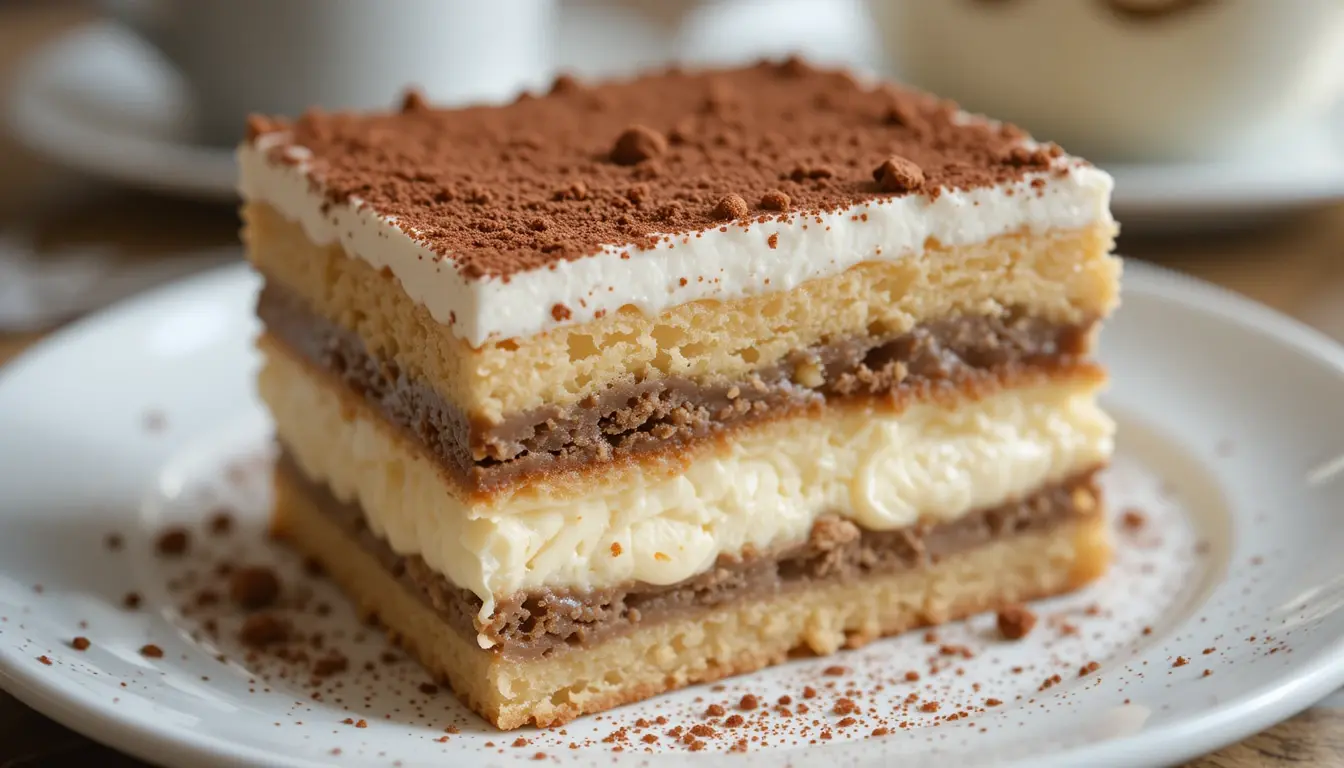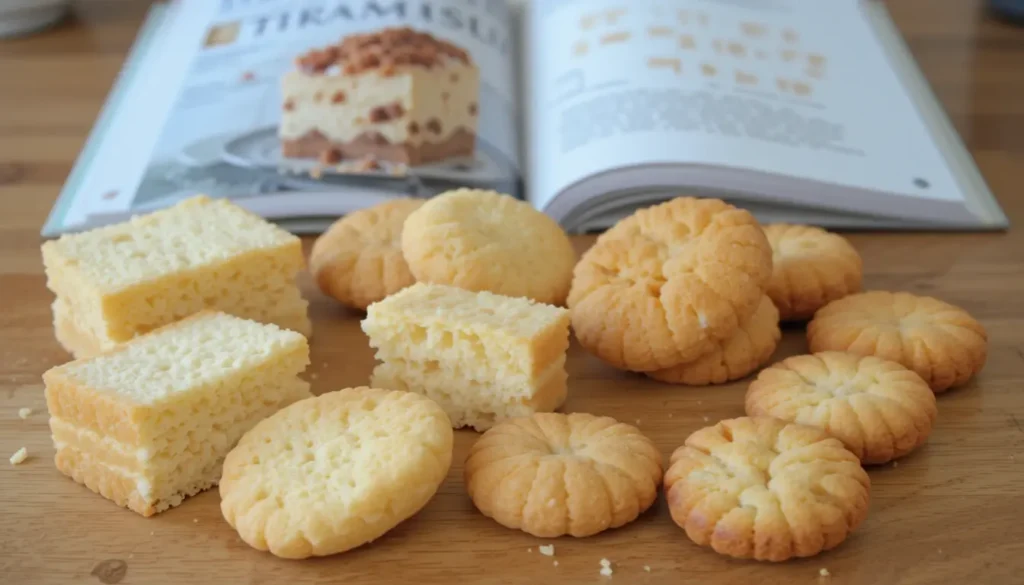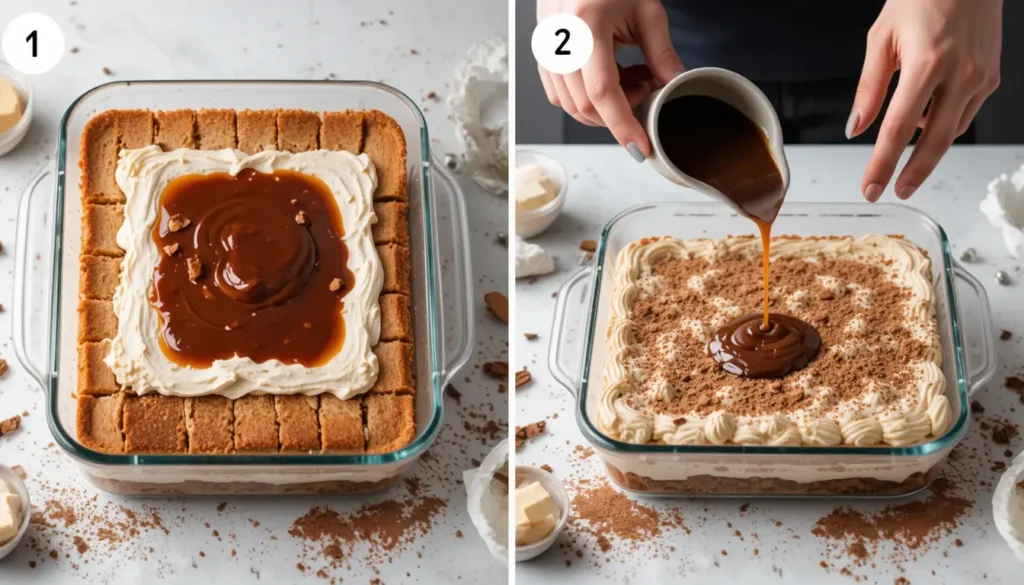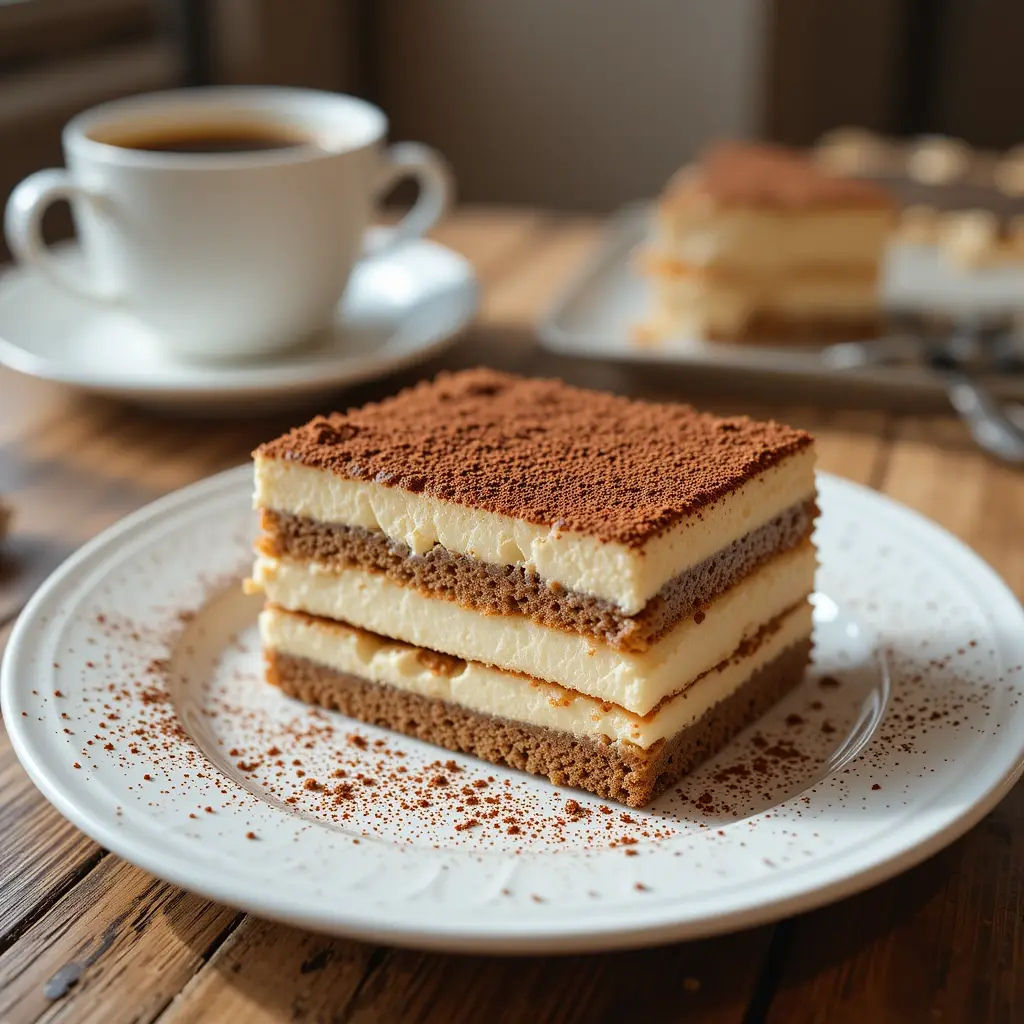Tiramisu is the ultimate dessert that makes anyone feel like a fancy Italian chef after just one bite. Its creamy layers, coffee-soaked biscuits, and rich mascarpone make it a showstopper at any table. But what happens if you’re all set to make tiramisu, only to realize you’re out of ladyfingers? That’s when the question pops up: Can you use shortbread instead of ladyfingers in tiramisu?
The short answer? Yes, but with a few considerations. In this article, we’ll dive into the nitty-gritty of substituting shortbread for ladyfingers, the adjustments you might need, and whether this swap can live up to the tiramisu tradition.
Table of Contents
Understanding Tiramisu and Its Key Ingredients
Tiramisu is not just any dessert; it’s an icon. Translating to “pick me up” in Italian, tiramisu is a layered treat of espresso-drenched ladyfingers, mascarpone cheese, cocoa powder, and sometimes a touch of liqueur. Each component plays a critical role in its success.
The Role of Ladyfingers in Traditional Tiramisu
Ladyfingers, or savoiardi, are light and airy biscuits that soak up coffee without falling apart. They’re the unsung heroes of tiramisu, holding the dessert together while offering a soft texture that melts in your mouth. Without them, tiramisu risks losing its signature structure and flavor.
What Makes Ladyfingers Unique?
Ladyfingers have a spongy, dry texture that balances perfectly with the wet ingredients in tiramisu. They’re not overly sweet, making them a neutral base for the bold espresso and creamy mascarpone to shine. That balance is why they’ve remained the traditional choice for decades.
Exploring Shortbread as a Substitute for Ladyfingers
So, where does shortbread come into the picture? If you’ve ever tasted shortbread, you know it’s rich, buttery, and crumbly. While these qualities make shortbread delicious on its own, they also make it quite different from ladyfingers. But that doesn’t mean it can’t work in tiramisu—it just means you’ll need to tweak a few things.
Characteristics of Shortbread Compared to Ladyfingers
Shortbread is denser and sweeter than ladyfingers, with a melt-in-your-mouth texture that can either enhance or disrupt your tiramisu experience, depending on how it’s used. Unlike ladyfingers, shortbread doesn’t absorb liquid as easily, which can be both a challenge and an opportunity when adapting your recipe.
Pros and Cons of Using Shortbread in Tiramisu
Pros:
- Shortbread’s buttery richness can add depth to the dessert.
- It’s widely available and easier to find than ladyfingers in some places.
- The crumbly texture provides an interesting twist.
Cons:
- It may make the tiramisu overly sweet if not balanced correctly.
- Shortbread’s lack of sponginess might affect the dessert’s structure.
- It requires extra care to prevent it from getting soggy or falling apart.
Adjustments Needed When Using Shortbread in Tiramisu
Substituting shortbread for ladyfingers isn’t a simple one-to-one swap. If you’re not careful, your tiramisu might turn out too sweet, too crumbly, or just plain soggy. But don’t worry—we’ve got you covered.
Balancing Sweetness and Texture
Shortbread is naturally sweeter than ladyfingers, so you’ll need to counterbalance that sweetness elsewhere in the recipe. You can reduce the amount of sugar in the mascarpone mixture or skip adding extra sweeteners to the coffee soak.
Texture is another hurdle. Since shortbread lacks the airy structure of ladyfingers, it’s best to use slightly thicker slices or break it into manageable pieces. Avoid crushing it too much, or it’ll turn into mush when soaked.
Adapting the Soaking Method for Shortbread
Ladyfingers are designed to soak up espresso quickly, but shortbread needs more careful handling. Dip the shortbread briefly into the coffee mixture—don’t let it sit, or it’ll absorb too much liquid and lose its crumbly texture.
If you’re worried about sogginess, consider brushing the coffee onto the shortbread instead of dunking it. This method gives you more control over the amount of liquid each piece absorbs.
Flavor Profile Differences Between Ladyfingers and Shortbread

When swapping ladyfingers for shortbread in tiramisu, understanding the flavor differences is crucial. Ladyfingers are neutral, letting the bold flavors of coffee, mascarpone, and cocoa powder take center stage. Shortbread, however, brings a buttery richness that can either enhance the dessert or overshadow its delicate balance.
How Shortbread Affects the Tiramisu Experience
Imagine the classic tiramisu experience: each bite is light, creamy, and perfectly balanced between bitter espresso and subtle sweetness. Using shortbread can alter this dynamic. The buttery undertone of shortbread adds richness, which pairs beautifully with the mascarpone. However, its sweetness may compete with the coffee’s bitterness, making the tiramisu feel heavier.
This means you’ll need to adjust other ingredients to let shortbread harmonize with the dessert. Reducing sugar in the mascarpone mixture or adding a touch more espresso can help create a balanced flavor profile.
Best Flavor Pairings When Using Shortbread
To complement the buttery notes of shortbread, you can tweak the traditional recipe slightly. For example:
- Use a stronger coffee blend or espresso to cut through the richness.
- Add a splash of dark rum or coffee liqueur for depth.
- Consider sprinkling a hint of sea salt over the layers to accentuate the shortbread’s flavor without overwhelming the dessert.
These small adjustments can elevate your tiramisu into a unique variation while staying true to its essence.
Practical Tips for Making Tiramisu with Shortbread
Substituting shortbread for ladyfingers might feel intimidating, but with a few clever tricks, you can make it work seamlessly.
Preparing Shortbread for Layering
Shortbread, being crumbly and dense, needs a little extra prep. Slice it into evenly-sized pieces to ensure a uniform layer. If you’re using store-bought shortbread, choose thicker pieces that won’t disintegrate when soaked.
For homemade shortbread, consider baking it slightly firmer than usual to mimic the texture of ladyfingers. Adding a touch of cornstarch to your shortbread dough can also help it hold its shape better when layered.
Preventing Sogginess in Shortbread Layers
Nobody wants a soggy tiramisu, and shortbread is more prone to this problem than ladyfingers. Here are some tips to prevent this issue:
- Quick Dips: Dip the shortbread briefly into the coffee or espresso mixture—just enough to coat the surface.
- Layer Strategically: Use mascarpone to create a barrier between the shortbread and the next layer of coffee-soaked biscuits.
- Chill Well: Tiramisu sets best when chilled for several hours, allowing the layers to firm up without becoming mushy.
These steps will ensure your tiramisu has a creamy consistency with layers that hold their shape.
Common Problems When Substituting Shortbread for Ladyfingers
Using shortbread instead of ladyfingers can come with its own set of challenges. Anticipating these potential pitfalls will help you troubleshoot effectively.
Structural Issues in Tiramisu with Shortbread
One common issue is the dessert collapsing due to shortbread’s crumbly nature. Unlike ladyfingers, which provide a sturdy base, shortbread can break apart under pressure. To combat this:
- Avoid oversaturating the shortbread with coffee.
- Layer the mascarpone mixture generously for added support.
- Press each layer gently to create a cohesive structure.
Overpowering Sweetness: How to Counterbalance
Shortbread’s natural sweetness might make the tiramisu overly cloying. If this happens, consider adding elements to cut through the sweetness:
- Use unsweetened cocoa powder liberally as a topping.
- Include a layer of fresh berries or tart fruits like raspberries.
- Add a pinch of espresso powder to the mascarpone mixture for a hint of bitterness.
By balancing sweetness with contrasting flavors, you can create a tiramisu that’s both rich and refined.
Creative Twists: Other Substitutes for Ladyfingers

If shortbread isn’t quite your style or you’re feeling adventurous, there are several other substitutes you can try. Tiramisu is surprisingly versatile, and with the right adjustments, many different bases can create a delightful dessert.
Using Sponge Cake or Pound Cake
Sponge cake is an excellent alternative to ladyfingers due to its light and airy texture. Like ladyfingers, sponge cake soaks up coffee without becoming too heavy. You can cut it into strips to mimic the shape of ladyfingers or layer it as-is for a modern twist.
Pound cake, on the other hand, offers a denser, buttery option similar to shortbread. Its moist texture makes it easy to layer, but be cautious with soaking—it absorbs liquid quickly, so a light brush of espresso may work better than dipping.
Experimenting with Biscotti or Savoiardi Alternatives

Biscotti might seem like an unconventional choice, but their firm texture makes them ideal for soaking. Choose a plain or lightly flavored variety to avoid clashing with the classic tiramisu ingredients. Keep in mind that biscotti will need a longer soaking time compared to ladyfingers or shortbread.
Savoiardi alternatives, such as eggless biscuits or gluten-free options, are great for those with dietary restrictions. Many specialty stores now offer alternatives that mimic the texture and flavor of traditional ladyfingers, making it easier to maintain authenticity in your tiramisu.
Expert Opinions on Substituting Ingredients in Tiramisu
What do the experts have to say about tinkering with this iconic dessert? Whether it’s professional chefs or home bakers, opinions vary widely—but they all agree on one thing: substitutions are fair game as long as you keep the spirit of tiramisu alive.
Professional Chefs’ Views on Shortbread in Tiramisu
Many professional chefs embrace creativity in the kitchen. Substituting shortbread for ladyfingers is often seen as an innovative twist rather than a culinary faux pas. Renowned chefs suggest focusing on balance—shortbread’s buttery flavor should complement, not overshadow, the espresso and mascarpone.
Chefs also recommend experimenting with proportions. Using slightly thinner layers of shortbread can help mimic the lightness of traditional tiramisu, ensuring the dessert remains harmonious.
Home Bakers’ Experiences and Feedback
Home bakers, the true champions of dessert experimentation, have plenty to say about using shortbread in tiramisu. Many rave about the added richness and depth shortbread brings, while others caution against its tendency to crumble under pressure.
One common tip from home bakers is to taste as you go. Since shortbread is sweeter than ladyfingers, adjusting the sweetness of the mascarpone mixture or coffee soak is essential to achieving a well-rounded flavor.
Final Thoughts on Using Shortbread in Tiramisu
Is substituting shortbread for ladyfingers in tiramisu a risk worth taking? Absolutely. While it may not replicate the traditional experience exactly, shortbread offers a unique take on this beloved dessert that’s rich, buttery, and indulgent.
Is It Worth the Substitution?
For anyone looking to experiment or who simply doesn’t have access to ladyfingers, shortbread can be a delightful alternative. The key lies in balancing its rich sweetness with the bold flavors of espresso and mascarpone. With a few careful adjustments, you can create a tiramisu that’s both familiar and refreshingly different.
Perfecting the Art of Customizing Tiramisu
Tiramisu isn’t a rigid recipe; it’s an evolving tradition that invites creativity. Whether you’re using shortbread, sponge cake, or any other substitute, the most important ingredient is your own personal touch.
Take the opportunity to customize your tiramisu to suit your tastes. Add a sprinkle of cinnamon, a dash of your favorite liqueur, or even a layer of caramelized nuts. By experimenting, you’ll not only create a dessert that’s uniquely yours but also keep the spirit of tiramisu alive for the next generation of bakers.
FAQs
Can you really use shortbread instead of ladyfingers in tiramisu?
Yes, shortbread can be used as a substitute for ladyfingers. However, you’ll need to adjust for its sweetness and crumbly texture to achieve the right balance.
How do you prevent shortbread from getting soggy in tiramisu?
Avoid over-soaking the shortbread in espresso. A quick dip or a light brushing of coffee will prevent it from becoming too soft.
What other substitutes work well in tiramisu?
Sponge cake, pound cake, and biscotti are excellent alternatives to ladyfingers. Each offers a unique texture and flavor to the dessert.
Does using shortbread change the flavor of tiramisu?
Yes, shortbread’s buttery richness adds a different dimension to the flavor. With proper adjustments, it can complement the traditional coffee and mascarpone notes.
Are there any gluten-free options for tiramisu bases?
Absolutely. Gluten-free biscuits or homemade sponge cake using gluten-free flour are great substitutes for traditional ladyfingers.
Can tiramisu be made without coffee?
Yes, for those who don’t enjoy coffee, alternatives like hot chocolate, fruit juice, or tea can be used for soaking the biscuit layers.
Related Reads
Enhance your tiramisu knowledge by exploring these articles:
- Where Did Ladyfinger Cookies Originate? A deep dive into the history of ladyfingers and their place in desserts.
- What is a Good Substitute for Biscuit Base? Perfect for experimenting with alternative dessert bases.
- The Best Biscuit for Cheesecake Base Ideas for biscuit swaps that also work for tiramisu!
Shortbread Tiramisu
A delightful twist on classic tiramisu, featuring buttery shortbread layers soaked in coffee and layered with rich, creamy mascarpone filling!
- Total Time: 5 minute
- Yield: 6 servings 1x
Ingredients
- 200g shortbread cookies
- 250g mascarpone cheese
- 200ml heavy cream
- 50g powdered sugar
- 1 tsp vanilla extract
- 1 cup strong brewed coffee, cooled
- 2 tbsp cocoa powder
Instructions
- In a bowl, whisk together mascarpone, heavy cream, powdered sugar, and vanilla extract until smooth and fluffy.
- Dip each shortbread cookie briefly into the brewed coffee, ensuring they are moistened but not soggy.
- Arrange a layer of coffee-soaked shortbread cookies in a serving dish.
- Spread half of the mascarpone mixture over the cookies.
- Repeat with another layer of coffee-dipped cookies and top with the remaining mascarpone mixture.
- Dust generously with cocoa powder.
- Refrigerate for at least 4 hours or overnight for the best flavor.
- Serve chilled and enjoy!
- Prep Time: 15 Min
- Chill Time: 4 hrs
Nutrition
- Serving Size: 6
- Calories: ~320 kcal per serving

